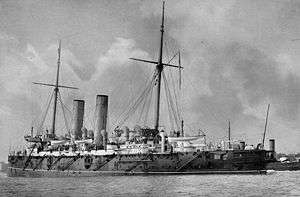HMS Gibraltar (1892)
 HMS Gibraltar | |
| History | |
|---|---|
| Name: | HMS Gibraltar |
| Builder: | Napier, Glasgow |
| Laid down: | 2 December 1889 |
| Launched: | 27 April 1892 |
| Reclassified: | Depot ship 1914 |
| Fate: | Sold for breaking up September 1923 |
| General characteristics | |
| Class and type: | Edgar-class cruiser |
| Displacement: | 7,770 tons |
| Length: | 387.5 ft (118.1 m) |
| Beam: | 60 ft (18 m) |
| Draught: | 24 ft (7.3 m) |
| Propulsion: | 2 shafts, 12,000hp |
| Speed: | 20 kn (37 km/h) |
| Range: | 10,000 nautical miles (19,000 km) at 10 knots (19 km/h) |
| Complement: | 544 |
| Armament: |
|
| Armour: |
|
HMS Gibraltar, was an Edgar-class cruiser launched in 1892 for service in the Royal Navy. She was built and engineered by Messrs Napier of Glasgow. Of 7,700 loaded displacement, she was coal-fired with four double-ended cylindrical boilers driving two shafts. She could make 20 knots (37 km/h) with forced draught and 18 knots (33 km/h) with natural draught. She was a very good sea boat and an exceptional steamer.
Service history
During her early career Gibraltar served mainly on foreign stations. In late 1899 she had a complete refit at Portsmouth dockyard.[1] In March 1901 she was commissioned by Captain Arthur Limpus, with a complement of 544 officers and men, to take the place as flagship of Rear-Admiral Arthur Moore, who had been appointed Commander-in-Chief on the Cape Station.[2] She arrived in Durban in early September 1901.[3]
In July 1902 she was head of a group of seven Royal Navy ships visiting Zanzibar for a show of force following the death of the sultan and accession of his son.[4]
Despite her obsolescence, she saw service in the First World War, first with the 10th Cruiser Squadron on Northern Patrol and from 1915 as a depot ship for this group, based in the Shetland Islands. Two of her 6-in QF Mk I guns were dismounted from the cruiser and moved to Swarbacks Head on Vementry, a headland that overlooks the entrance to Swarbacks Minn between the islands of Vementry and Muckle Roe for shore based defence. The two guns still exist on this site and can be visited.[5]
Future First Sea Lord John H. D. Cunningham served aboard her as a midshipman. Captain Ronald Arthur Hopwood, R.N. was in command 1913–1914, leaving at the start of the First World War.
Gibraltar was sold in August 1923 to John Cashmore Ltd for breaking up at Newport.
References
- ↑ "Naval & Military intelligence". The Times (36027). London. 1 January 1900. p. 7.
- ↑ "Naval & Military intelligence". The Times (36395). London. 6 March 1901. p. 10.
- ↑ "Naval & Military intelligence". The Times (36554). London. 7 September 1901. p. 10.
- ↑ "Zanzibar". The Times (36825). London. 21 July 1902. p. 5.
- ↑ http://www.fsgfort.com/uploads/pdfs/Public/Clements%20C90%20Pb2.pdf
Publications
- Colledge, J. J.; Warlow, Ben (2006) [1969]. Ships of the Royal Navy: The Complete Record of all Fighting Ships of the Royal Navy (Rev. ed.). London: Chatham Publishing. ISBN 978-1-86176-281-8. OCLC 67375475.
- Roger Chesneau and Eugene M. Kolesnik, ed., Conway's All The Worlds Fighting Ships, 1860-1905, (Conway Maritime Press, London, 1979), ISBN 0-85177-133-5